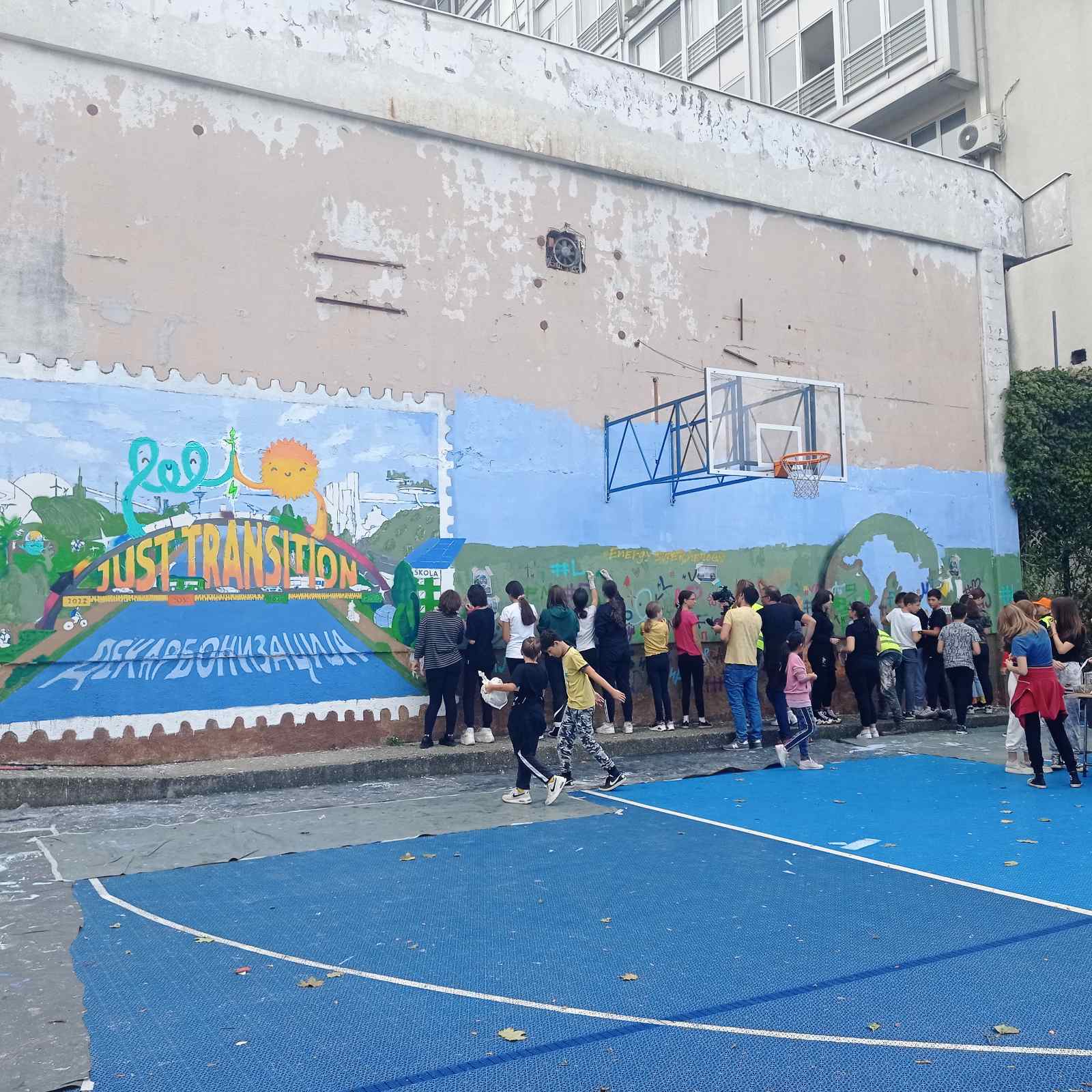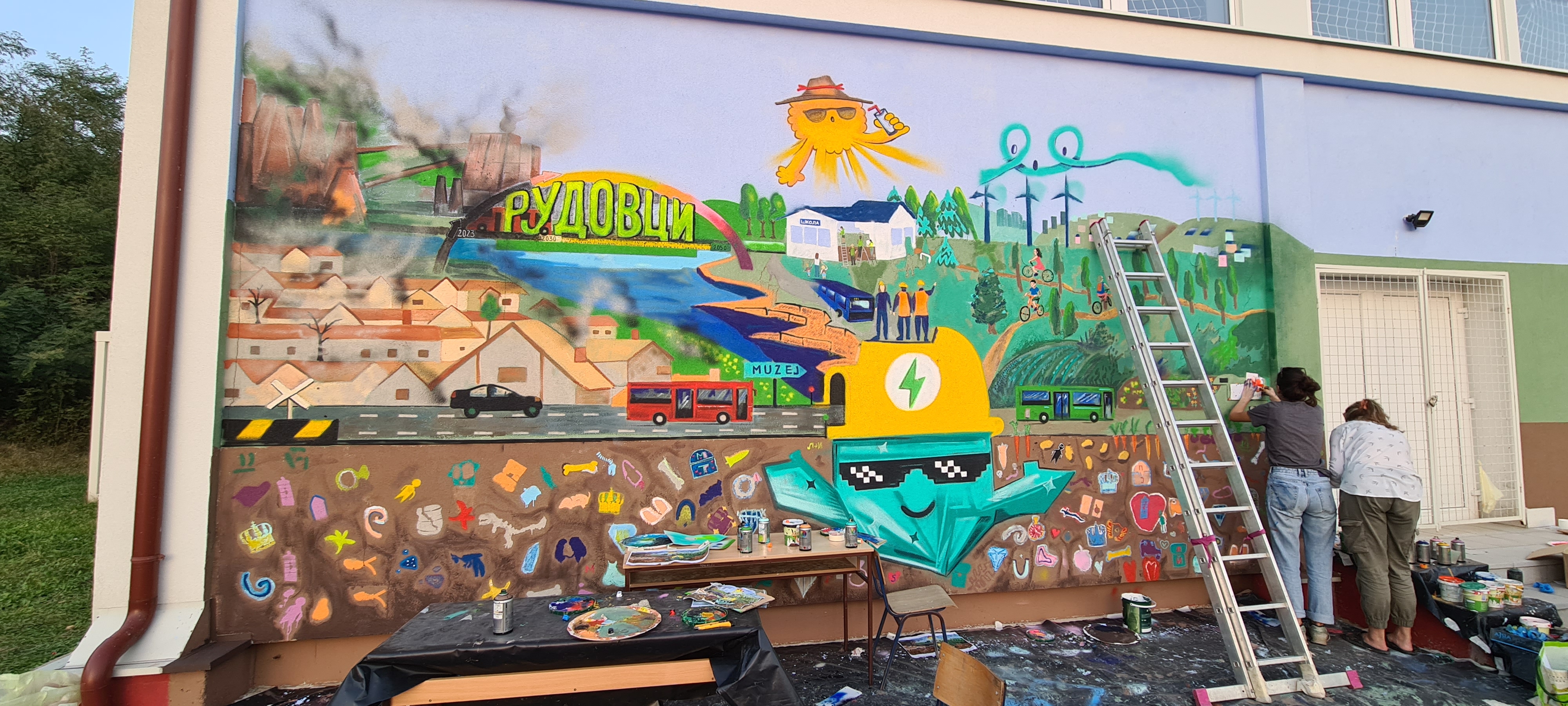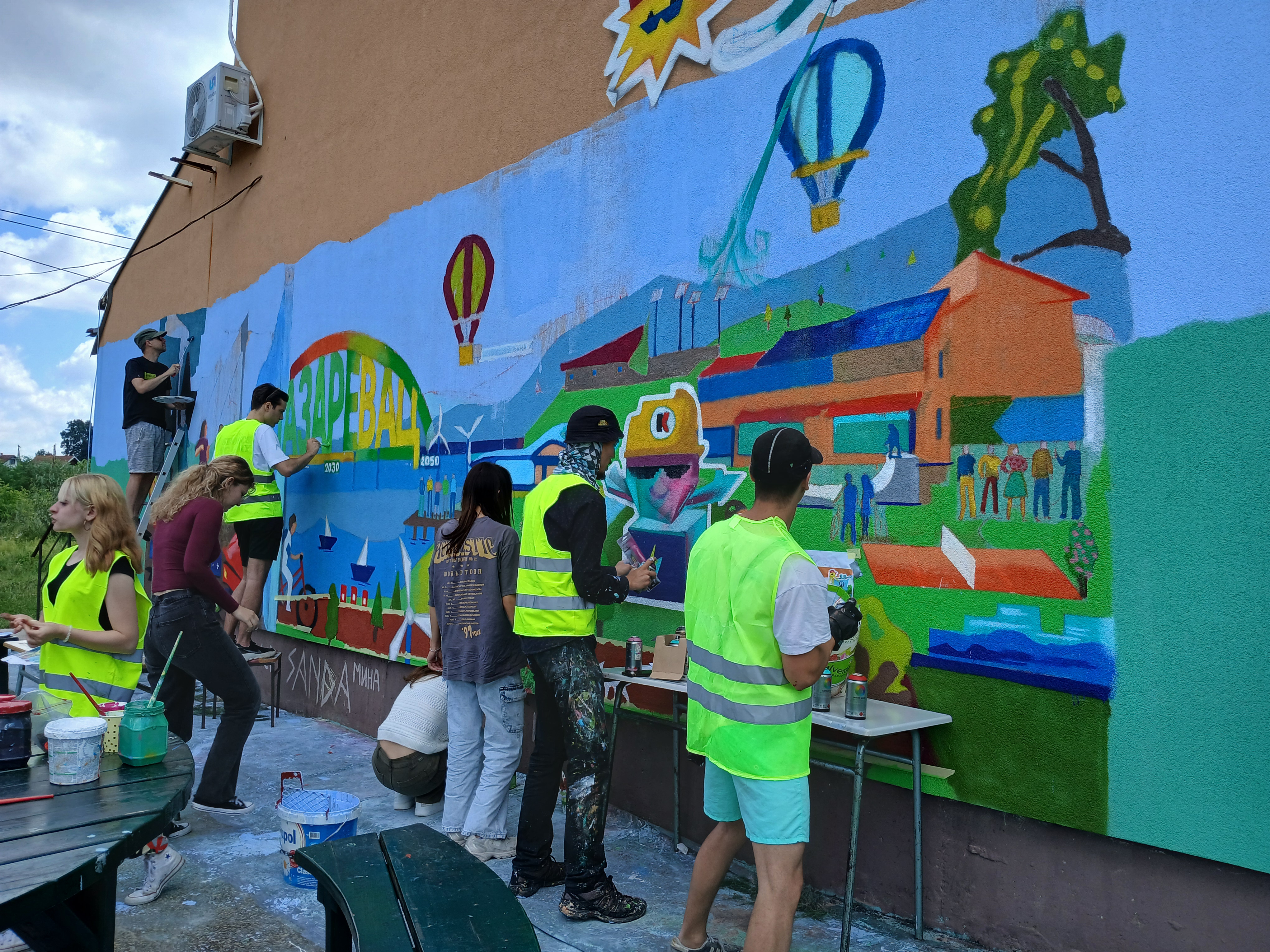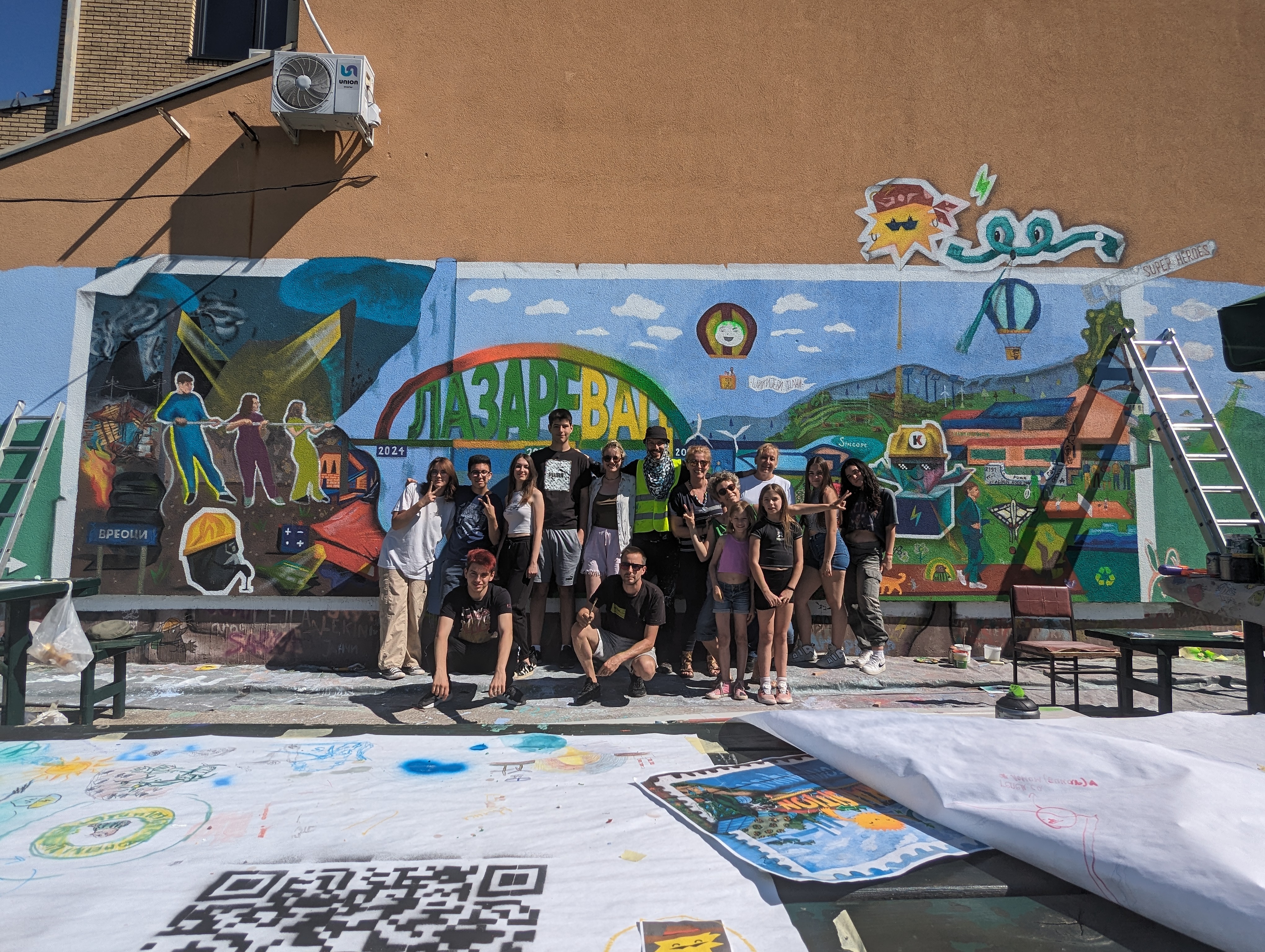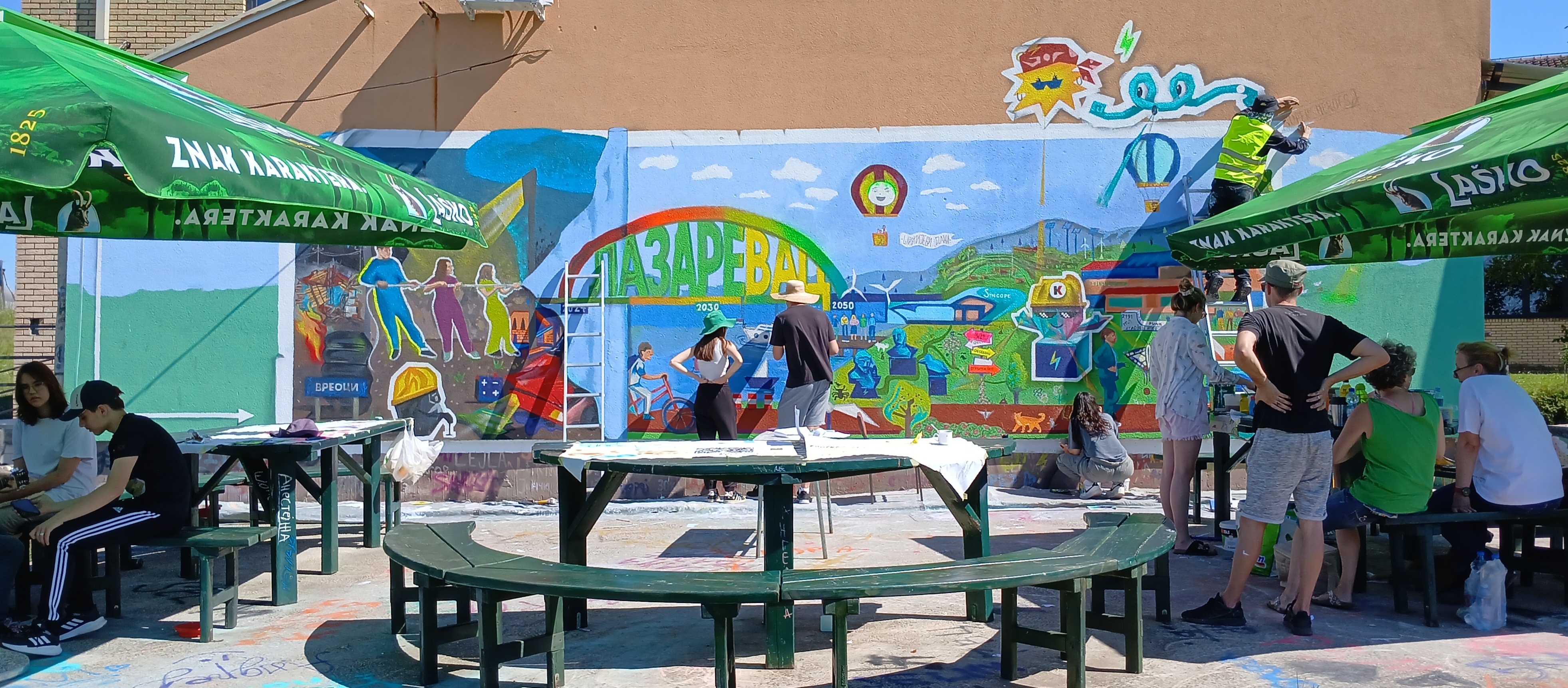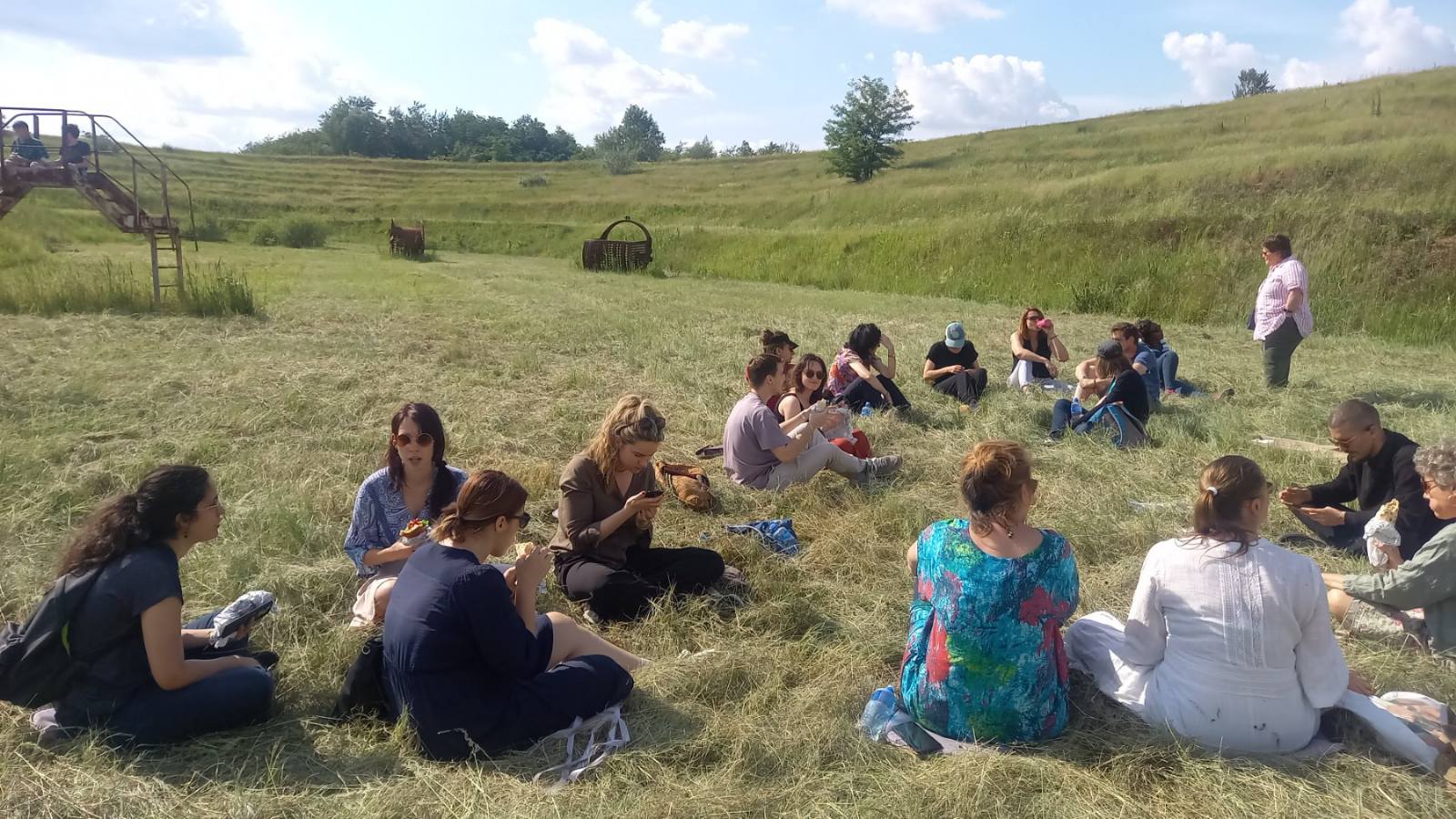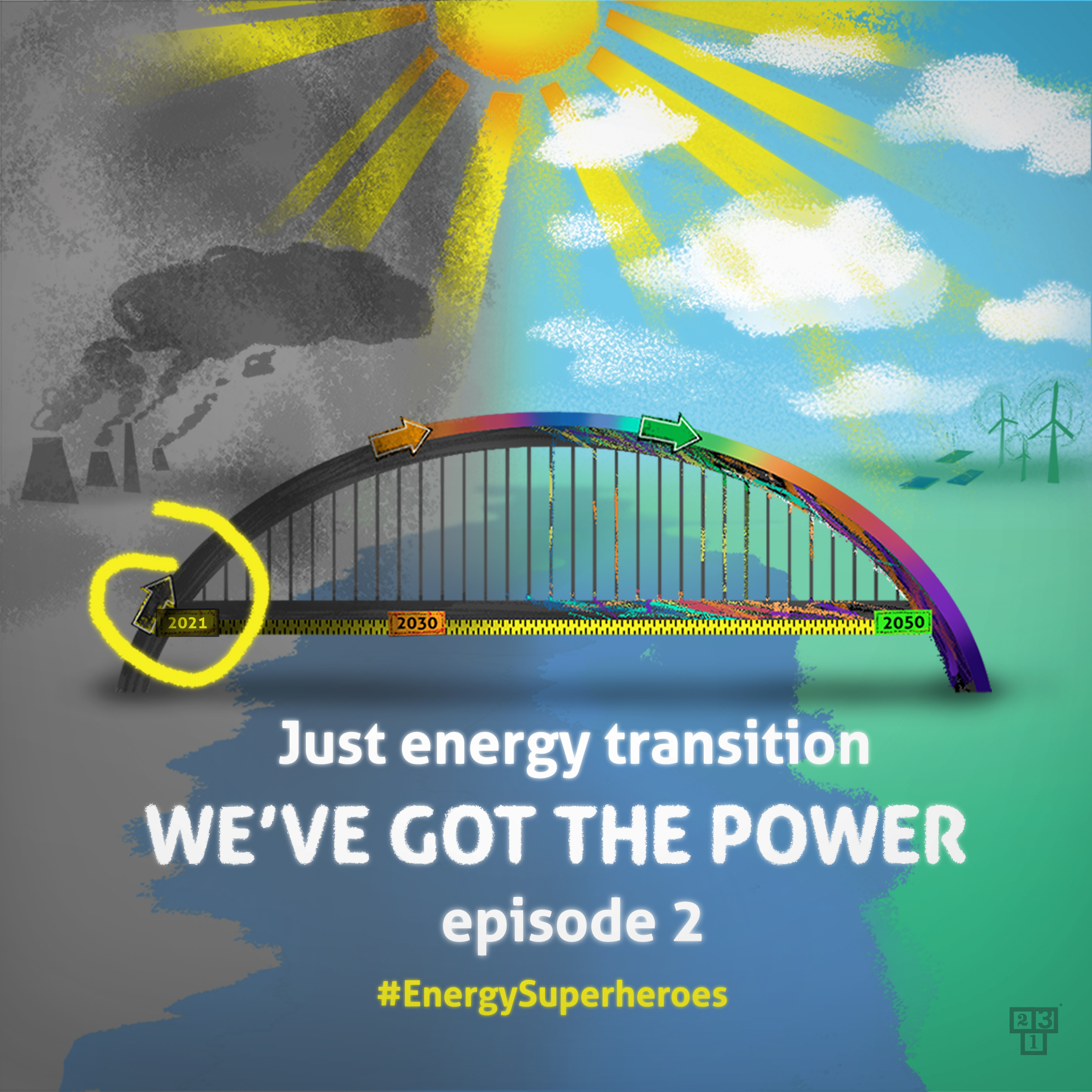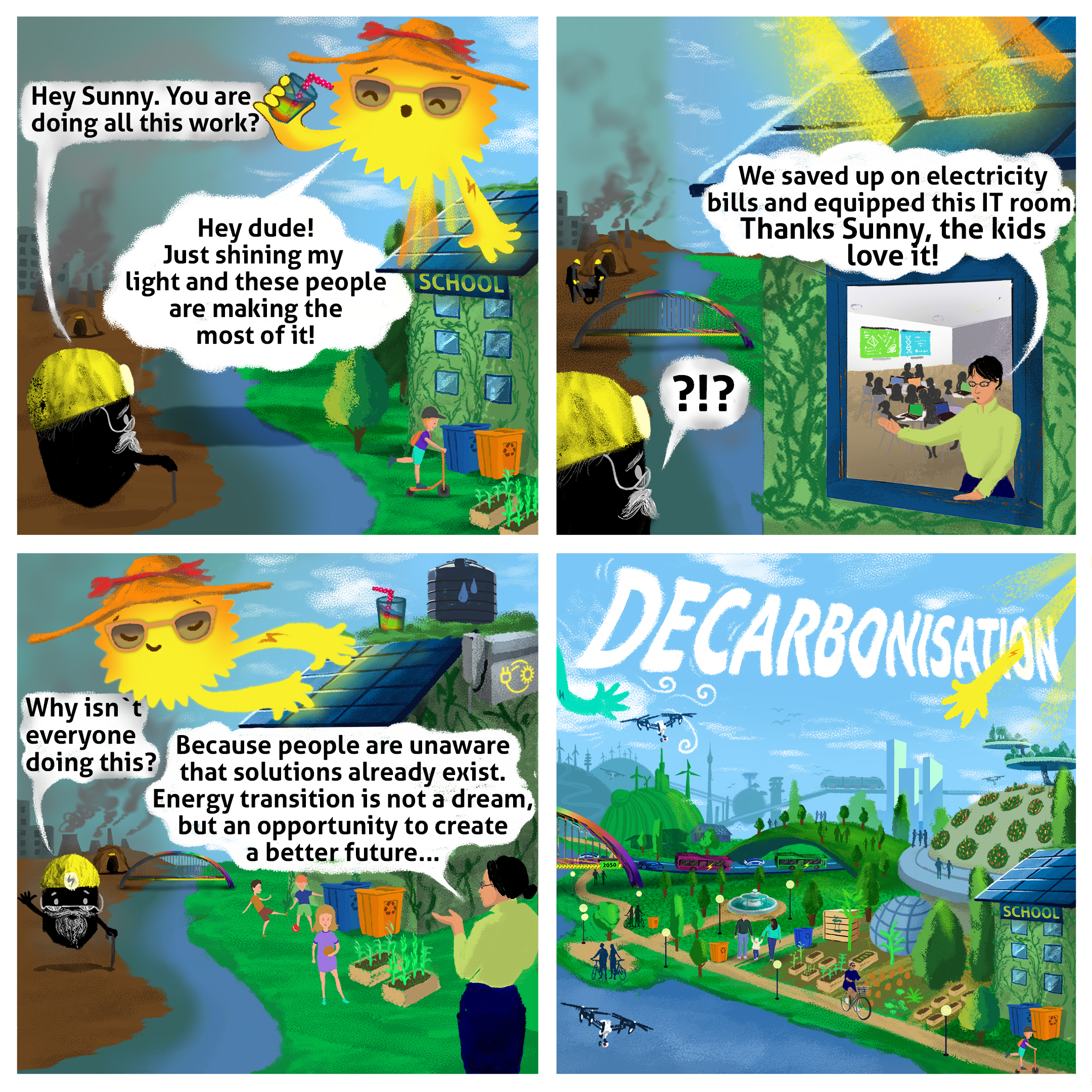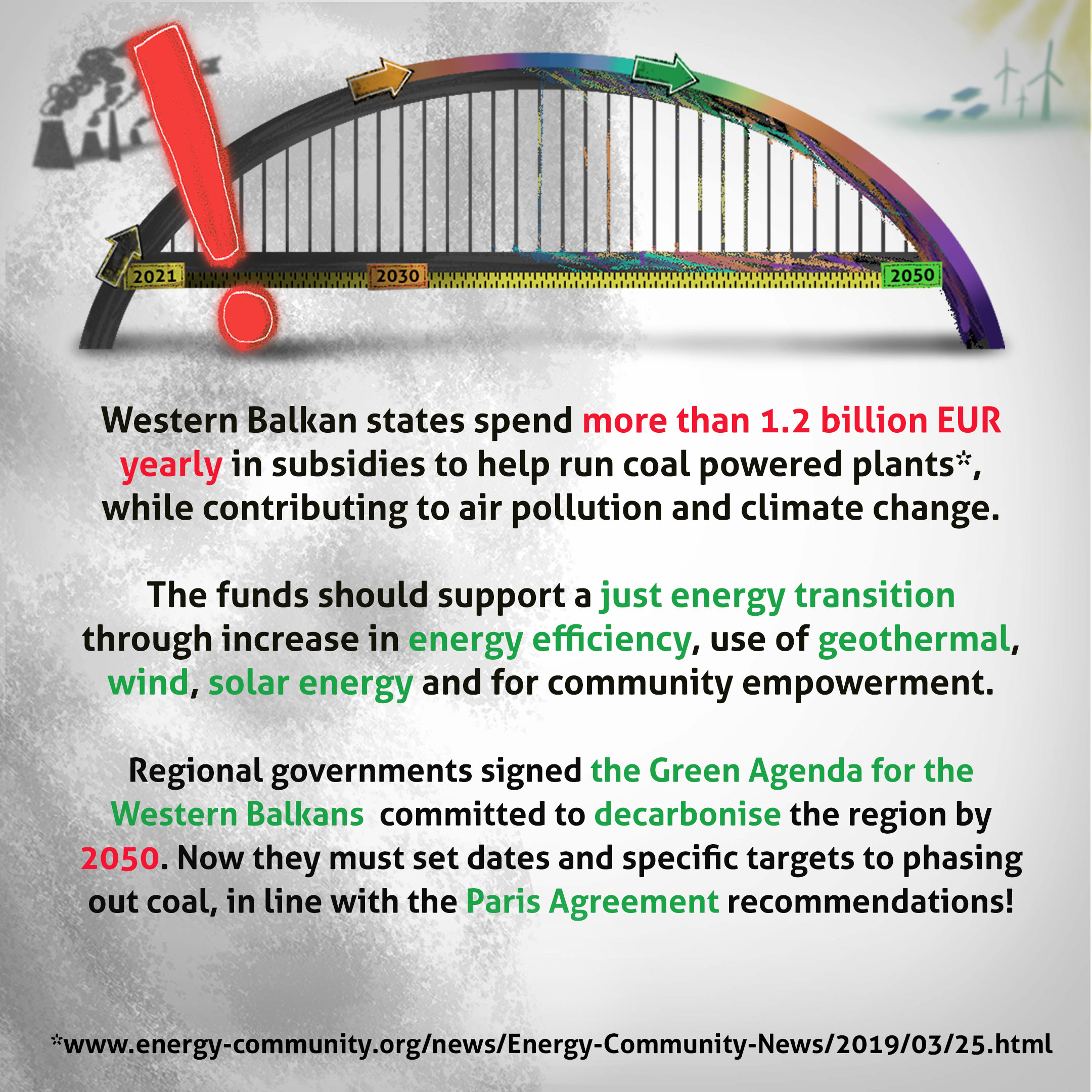Regaining a sense of belonging
Eco-murals for a Just Transition
{Empty}
Project applies interactive eco-mural painting as the platform to open up informed discussion amongst youth about a just energy transition in local coal-impacted communities in Serbia. EnergySuperheroes comic characters are drawn with air-cleaning paint, and later brought to interactive life via an Augmented Reality app. Interactive discussions and artistic workshops are topped with a tree planting activity, drawing a full circle with a message that noone should be left out.
Serbia
National
Mainly urban
It refers to other types of transformations (soft investment)
Yes
2024-10-31
No
No
No
As an individual
The project ‘Eco-murals for a just transition’, essentially a communications campaign, centres on an interactive, authentic creative tool - drawing murals with air-cleaning paints in school yards - as a platform for an open and informed discussion on topics that are taboo - in this case coal-phaseout in local communities where coal is the lifeline of the entire geographical area. The project tool has been applied in three urban places - mural no.1 piloted in Belgrade (2022), no.2 the village Rudovci (2023), and no.3 in the town of Lazarevac (2024) in central Serbia - namely the cradle and the administrative centre of coal production in Serbia. Key project outcome: prepare young people to take active part in a topic that determines their future - namely deployment of renewable energy sources coupled with energy efficiency. Mural design originate in the #EnergySuperheroes comic and the supporting narrative. Prior to painting the mural pupils are engaged in workshops to discuss the topic, create stencils and contribute towards the final composition of the mural. Youngsters, and other stakeholders, integrate the messages almost automatically, learning about decarbonisation, the need to clean the air and use clean energy sources such as solar and wind, and also to send coal to retire. Children, scool staff and local community members, learned while creating something beautiful.
Each mural was communicated to the wider public by engaging social-media influencers and reaching thousands of viewers across Serbia and the region. The final activity of each project is trees planting together with pupils and school staff. Symbolism of this activity is to remind us that nature is our best ally in curbing climate change, while technological approaches should only serve as the additional tool in humanity’s fight towards better environmental protection and adapting to climate change.
https://caneurope.org/energy-superheroes-stripovi/
Each mural was communicated to the wider public by engaging social-media influencers and reaching thousands of viewers across Serbia and the region. The final activity of each project is trees planting together with pupils and school staff. Symbolism of this activity is to remind us that nature is our best ally in curbing climate change, while technological approaches should only serve as the additional tool in humanity’s fight towards better environmental protection and adapting to climate change.
https://caneurope.org/energy-superheroes-stripovi/
interactive
participatory
open discussion
fun
empowering
Sustainability is achieved by ensuring ownership of the process. Interactive workshops with pupils and school staff discussed key topics, finalising the mural sketch and integrating local community landmarks, introducing EnergySuperheros comic characters and messages, mural graffiti-spray painting, engaging with pupils, their interests and opening the space to hear them. Complex topics such as climate change, coal phase-out, deployment of renewable energy sources, and the EU Green Agenda are communicated in indirect and simple context, via the lens of air pollution. Serbia is signatory of the Paris Agreement, and subsequent political declarations and agreements. Young people are the bearers of change, hence the project focus.
Energy production from coal is one of the key global contributors towards climate change. The Western Balkans region relies on coal as the primary source for power production. The energy sector in the Western Balkans is the leading sector for emitting greenhouse gas emissions, accounting for around 75% of all greenhouse gas emissions in the region Deathly pollutants emitted from 18 thermal power plants across the region caused nearly 19,000 related deaths from 2018 to 2020.
Lazarevac is home to Serbia’s largest coal mining complex, RB Kolubara (Rudarski Basen Kolubara), the largest division of the state-owned Electric Power Industry of Serbia. RB Kolubara provides around 75% of the lignite used for EPS’ thermal generation. The headquarters of RB Kolubara is located in Lazarevac, and Rudovci is the village where coal-mining started. 80% of the population rely on coal.
What happens to them if/when coal is phased-out? This project focused on raising their awareness that the local community needs to be involved in the process, and that an open discussion needs to include all segments of the society.
Energy production from coal is one of the key global contributors towards climate change. The Western Balkans region relies on coal as the primary source for power production. The energy sector in the Western Balkans is the leading sector for emitting greenhouse gas emissions, accounting for around 75% of all greenhouse gas emissions in the region Deathly pollutants emitted from 18 thermal power plants across the region caused nearly 19,000 related deaths from 2018 to 2020.
Lazarevac is home to Serbia’s largest coal mining complex, RB Kolubara (Rudarski Basen Kolubara), the largest division of the state-owned Electric Power Industry of Serbia. RB Kolubara provides around 75% of the lignite used for EPS’ thermal generation. The headquarters of RB Kolubara is located in Lazarevac, and Rudovci is the village where coal-mining started. 80% of the population rely on coal.
What happens to them if/when coal is phased-out? This project focused on raising their awareness that the local community needs to be involved in the process, and that an open discussion needs to include all segments of the society.
The original aesthetic emerged for the comics we developed in collaboration with a team of visual artists, with each subsequent level incorporating input from the community. We worked closely with pupils and professors, shaping the visual identity together.
Aesthetically, we developed a kind of universal visual language—one that is adaptable and permeable to different sensibilities. Just as our team remained open to collaboration with various artists and anyone interested in participating, our aesthetic also evolved to embrace new elements and individual artistic expressions and local characters.
The design moved from three characters - woman, man and child - towards sun, wind and coal as the energy super heroes. The colour palette was based on CAN Europe colors, using vibrant and rainbow palette.
Aesthetically, we developed a kind of universal visual language—one that is adaptable and permeable to different sensibilities. Just as our team remained open to collaboration with various artists and anyone interested in participating, our aesthetic also evolved to embrace new elements and individual artistic expressions and local characters.
The design moved from three characters - woman, man and child - towards sun, wind and coal as the energy super heroes. The colour palette was based on CAN Europe colors, using vibrant and rainbow palette.
The United Nations broad definition of just transition is ‘ensuring that no one is left behind or pushed behind in the transition to low-carbon’. Although economically well off, the coal-dependent (and impacted) communities of Lazarevac and Rudovci are marginalised in terms of access to information and inclusion in the decision making process. Fear of losing economic security is far greater than the fear of breathing poisonous air pollution.
Eco-murals project developed as a communications campaign based on the research about perceptions of a coal-impacted community of Lazarevac, conducted by Climate Action Network Europe in 2020. Findings of that research were developed into #EnergySuperheroes comic, applied to local communities via three murals. The comic explains how a just transition can be achieved until 2050, the deadline which Serbia has signed to become carbon-neutral.
Each mural features a different moment, but retains the key concept of the bridge symbolising the time travel and looking at the present, which is polluted, taking us to 2050 when the environment has been cleaned. Mural no1. has the bridge as the central focus, Mural no2. has Coally placed as a diamond statue in the Museum of Coal, Mural no.3 focuses on the power of youth to make the change.
The project models a participatory democratic process whereby pupils are presented with options, asked for opinions, given the space to present their points of view, fears, plans, ideas.
For Mural no.3 we engaged a young influencer, Jibry Bell, of African-American origin, who visited the launch of the AR app and engaged with the pupils in fun and motivational encounters (watch here).
Various project layers and activities ensured that small communities feel empowered and given the opportunity to (re)evaluate their home towns. If you could make Lazarevac a better place to live maybe you wouldn’t have to leave when you grow up - was the key message delivered to the young people.
Eco-murals project developed as a communications campaign based on the research about perceptions of a coal-impacted community of Lazarevac, conducted by Climate Action Network Europe in 2020. Findings of that research were developed into #EnergySuperheroes comic, applied to local communities via three murals. The comic explains how a just transition can be achieved until 2050, the deadline which Serbia has signed to become carbon-neutral.
Each mural features a different moment, but retains the key concept of the bridge symbolising the time travel and looking at the present, which is polluted, taking us to 2050 when the environment has been cleaned. Mural no1. has the bridge as the central focus, Mural no2. has Coally placed as a diamond statue in the Museum of Coal, Mural no.3 focuses on the power of youth to make the change.
The project models a participatory democratic process whereby pupils are presented with options, asked for opinions, given the space to present their points of view, fears, plans, ideas.
For Mural no.3 we engaged a young influencer, Jibry Bell, of African-American origin, who visited the launch of the AR app and engaged with the pupils in fun and motivational encounters (watch here).
Various project layers and activities ensured that small communities feel empowered and given the opportunity to (re)evaluate their home towns. If you could make Lazarevac a better place to live maybe you wouldn’t have to leave when you grow up - was the key message delivered to the young people.
Pupils and school staff were (each time) involved in envisioning the future of their community. This process unfolded through workshops with students and school staff, as well as spontaneously during the mural painting, where we remained open to conversations with anyone who stopped by to watch.
The mural itself was initially sketched with a basic structure, with key comic characters Sunny, Windy and Coaly. It was intentionally left open to incorporate meaningful local details and ideas that emerged from our discussions with the community. Some of the local heroes were even depicted in the artwork, making it a true reflection of the people who shape their surroundings. For example Coaly (coal) is not a bad guy, even though he pollutes. He is old and understands that he must retire and leave the world to Sunny and Windy. When Coally stays in the ground he becomes a diamond - a metaphor with a message that coal is more valuable when left in the ground. This is portrayed in the AR application.
Through these activities, participants experienced a sense of agency—realizing that their wishes and needs matter and should be incorporated into development plans. Many conversations shifted in real time, transforming from defensive, stagnant narratives into moments of recognition and engagement. People felt seen and valued for sharing their perspectives, collectively thinking through the just transition process and imagining a brighter future together.
The mural itself was initially sketched with a basic structure, with key comic characters Sunny, Windy and Coaly. It was intentionally left open to incorporate meaningful local details and ideas that emerged from our discussions with the community. Some of the local heroes were even depicted in the artwork, making it a true reflection of the people who shape their surroundings. For example Coaly (coal) is not a bad guy, even though he pollutes. He is old and understands that he must retire and leave the world to Sunny and Windy. When Coally stays in the ground he becomes a diamond - a metaphor with a message that coal is more valuable when left in the ground. This is portrayed in the AR application.
Through these activities, participants experienced a sense of agency—realizing that their wishes and needs matter and should be incorporated into development plans. Many conversations shifted in real time, transforming from defensive, stagnant narratives into moments of recognition and engagement. People felt seen and valued for sharing their perspectives, collectively thinking through the just transition process and imagining a brighter future together.
In 2020 CAN Europe commissioned research about Just Transition attitudes in Lazarevac, with idea to initiate a topical debate in Lazarevac. Due to the political climate at the time this was not made possible despite a number of efforts by CAN Europe and Belgrade Open School (BOS).
In 2021 the EnergySuperheroes comic was designed by artistic team 1+1is3, on request by CAN Europe. The comic is translated to Serbian, Albanian and Macedonian and has been shared via CAN Europe members’ social media pages in the entire region. Comic characters were developed having in mind just-transition goals and moving away from the usual narrative - good guys v. bad guys. This is how Coally became an EnergySuperhero, respected by the community as the one who has, and still is, supplying us with light and heat.
From 2022 the EnergySuperheores comic descended from social media onto the walls of school playgrounds to become the Eco-murals project. Numerous local stakeholders have become involved. Primarily school staff, who accepted the (previously taboo) topic, then pupils and their parents, teachers, and the wider community via social media in primary school in Belgrade and Rudovci, and secondary school in Lazarevac.
The project team has merged efforts with other cultural and artistic efforts taking place near Kolubara. We attended a study trip organised by the winning consortium of the SANU (Serbian Academy of Science and Arts) Art and Science prize The future of liminal landscapes. In addition, Energija Kolubara, a monthly business magazine printed by the Energy company of Serbia (EPS), published news about the mural.
In 2021 the EnergySuperheroes comic was designed by artistic team 1+1is3, on request by CAN Europe. The comic is translated to Serbian, Albanian and Macedonian and has been shared via CAN Europe members’ social media pages in the entire region. Comic characters were developed having in mind just-transition goals and moving away from the usual narrative - good guys v. bad guys. This is how Coally became an EnergySuperhero, respected by the community as the one who has, and still is, supplying us with light and heat.
From 2022 the EnergySuperheores comic descended from social media onto the walls of school playgrounds to become the Eco-murals project. Numerous local stakeholders have become involved. Primarily school staff, who accepted the (previously taboo) topic, then pupils and their parents, teachers, and the wider community via social media in primary school in Belgrade and Rudovci, and secondary school in Lazarevac.
The project team has merged efforts with other cultural and artistic efforts taking place near Kolubara. We attended a study trip organised by the winning consortium of the SANU (Serbian Academy of Science and Arts) Art and Science prize The future of liminal landscapes. In addition, Energija Kolubara, a monthly business magazine printed by the Energy company of Serbia (EPS), published news about the mural.
The Energysuperheroes project involved environmental policy activists working on ensuring a just energy transition in Europe and wider. The comic messaging was created to dissect policy asks into a story comprehensive for the general public. Comic characters were developed together by policy activists, visual artists, film directors, teachers from across Europe and the Western Balkans to be able to convey the message of a just energy transition. The baseline of the story takes us from 2022 until 2050, during which time Coally retires, while Sunny and Windy are working with the community to show the potential for carbon-neutral change (see attached visuals).
Eco-murals project concept was recognised and joined by University professors from the Faculty of Forestry professors, RB Kolubara engineers, augmented reality educators, innovative technology of used colors, workshops, media communication. Three years of campaigning has opened up the space for a new project, to be implemented in 2025, taking place on the cultivated part of the coal mine - the Green Amphitheatre. This idea was initiated by the RB Kolubara engineers, and further developed by the 1+1is3 team to constitute Amphitheatre dialogues and make the cultivated space for future use of the local community. .
During the study trip on a tour around the RB Kolubara and were introduced to the coal-mine re-cultivation efforts, from 1980s. The curator was an engineer from RB Kolubara, Branislav B, who later attended the final event at Rudovci school. He sent the following message to the project team:
‘I am truly grateful for this kind gesture. The idea (of the mural) is fenomenal as it connects reality with imagination, nature with modern technology. I would have missed very much had I not come to Rudovci today. I am only sorry that I could not stay to plant a tree. Kind regards, Branislav P.’
Eco-murals project concept was recognised and joined by University professors from the Faculty of Forestry professors, RB Kolubara engineers, augmented reality educators, innovative technology of used colors, workshops, media communication. Three years of campaigning has opened up the space for a new project, to be implemented in 2025, taking place on the cultivated part of the coal mine - the Green Amphitheatre. This idea was initiated by the RB Kolubara engineers, and further developed by the 1+1is3 team to constitute Amphitheatre dialogues and make the cultivated space for future use of the local community. .
During the study trip on a tour around the RB Kolubara and were introduced to the coal-mine re-cultivation efforts, from 1980s. The curator was an engineer from RB Kolubara, Branislav B, who later attended the final event at Rudovci school. He sent the following message to the project team:
‘I am truly grateful for this kind gesture. The idea (of the mural) is fenomenal as it connects reality with imagination, nature with modern technology. I would have missed very much had I not come to Rudovci today. I am only sorry that I could not stay to plant a tree. Kind regards, Branislav P.’
Multilayered, interactive, educative, esthetic, artistic, fun and engaging approach mixed with a complex and crucial topic, and coupled with modern technocratic inventions (air-purifying paint and AR app), while not leaving out nature-based solutions, makes this project exemplary.
Painting a mural with graffiti is a beautiful work of art done by one or more artists. Engaging the entire school community to co-design and co-paint the mural is another dimension. We addressed decarbonisation, air pollution and applied participatory democracy through artistic engagement, coated with newest inventions and virtual reality technologies. The ripple effect of this communication approach touched hundreds of individuals in person, and reached out to thousands of viewers via social and traditional media channels.
The breakthrough which has been achieved via the EnergySuperheroes Eco-mural project is clearly showing the power of interactive and artistic campaigning approach which the project has at heart. Debating possible future solutions with pupils towards resolving air pollution is equivalent to planting a seed that will take time to grow. Through project activities over the space of 3 years the team directly reached around 1000 school children, and indirectly sent a message to their families and community members – teachers, the gymnasium staff and the local community who gathered during the painting.
The main conclusion of continuous efforts applied over the years through the project sequence is that gradual steps and innovative methodology are needed to achieve a fundamental change. Personal approach and interaction, creation of partnerships and trust, coupled with setting the stage for informal information sharing and learning are the recipe for change. The future belongs to young people, and they act as catalysts passing on the information to the ‘grownups’ who are in a position to initiate the change at this moment in time.
Painting a mural with graffiti is a beautiful work of art done by one or more artists. Engaging the entire school community to co-design and co-paint the mural is another dimension. We addressed decarbonisation, air pollution and applied participatory democracy through artistic engagement, coated with newest inventions and virtual reality technologies. The ripple effect of this communication approach touched hundreds of individuals in person, and reached out to thousands of viewers via social and traditional media channels.
The breakthrough which has been achieved via the EnergySuperheroes Eco-mural project is clearly showing the power of interactive and artistic campaigning approach which the project has at heart. Debating possible future solutions with pupils towards resolving air pollution is equivalent to planting a seed that will take time to grow. Through project activities over the space of 3 years the team directly reached around 1000 school children, and indirectly sent a message to their families and community members – teachers, the gymnasium staff and the local community who gathered during the painting.
The main conclusion of continuous efforts applied over the years through the project sequence is that gradual steps and innovative methodology are needed to achieve a fundamental change. Personal approach and interaction, creation of partnerships and trust, coupled with setting the stage for informal information sharing and learning are the recipe for change. The future belongs to young people, and they act as catalysts passing on the information to the ‘grownups’ who are in a position to initiate the change at this moment in time.
Part 1: Workshops: Creative workshops with children and school staff are integral part of the activity and serve to initiate conversation and open up the floor for discussion while making the props for graffiti painting. This activity also constitutes part of the communication/information efforts, at this stage the beneficiaries are teachers and/or local officials who will be introduced to the JT concept
Part 2: Eco-mural: The project is traditionally centered on engaging young people to prepare and draw an interactive, air cleaning mural painted with Boysen KNOxOUT paints that collect nitrogen dioxide from air and turn it into water vapour. According to research 1 m2 of paint cleans as much air pollution as a tree.
Part 3: Mural painting on a dedicated school wall: painting of the mural in total takes around 5 days. The mural sketch is outlined by the graffiti artists, while pupils/community are given the space to try out graffiti paint, to write a message, to engage with the process.
Part 4: Augmented Reality Application: key points on the mural are augmented making the comic characters come alive, telling stories of the coal-mine, recultivation efforts, potential for future. Each mural has its own AR app. This is an interactive way to engage pupils via their mobile phones, opening up the space for more information sharing and fun activities.
Part 5: Final event and Launch of the AR app: once the app is finalised a launch event is organised where local media and the wider community are invited. An influencer is also present to contribute towards sharing the message widely and gaining publicity amongst young people. Tree planting activity takes place during the final event, underlining the fact that air-cleaning paint is not the answer to environmental and climate crisis, but only nature-based solutions are.
Part 6: Social media campaign: engaged influencers have made short films and posted the story about Eco-mural on their social media channels.
Part 2: Eco-mural: The project is traditionally centered on engaging young people to prepare and draw an interactive, air cleaning mural painted with Boysen KNOxOUT paints that collect nitrogen dioxide from air and turn it into water vapour. According to research 1 m2 of paint cleans as much air pollution as a tree.
Part 3: Mural painting on a dedicated school wall: painting of the mural in total takes around 5 days. The mural sketch is outlined by the graffiti artists, while pupils/community are given the space to try out graffiti paint, to write a message, to engage with the process.
Part 4: Augmented Reality Application: key points on the mural are augmented making the comic characters come alive, telling stories of the coal-mine, recultivation efforts, potential for future. Each mural has its own AR app. This is an interactive way to engage pupils via their mobile phones, opening up the space for more information sharing and fun activities.
Part 5: Final event and Launch of the AR app: once the app is finalised a launch event is organised where local media and the wider community are invited. An influencer is also present to contribute towards sharing the message widely and gaining publicity amongst young people. Tree planting activity takes place during the final event, underlining the fact that air-cleaning paint is not the answer to environmental and climate crisis, but only nature-based solutions are.
Part 6: Social media campaign: engaged influencers have made short films and posted the story about Eco-mural on their social media channels.
Project methodology can be applied to any topic, with moderations to its parts whether artistic or topical.
Link to CAN Europe comics https://caneurope.org/campaigns/energysuperheroes_comic/
Link to CAN Europe comics https://caneurope.org/campaigns/energysuperheroes_comic/
The project addresses climate change , air pollution from coal production, decarbonization by 2050, just energy transition, open and free space for discussion and community engagement with issues that concern them.
It also addresses youth engagement and empowering, through fun and interaction with various generations and nations.
It also addresses youth engagement and empowering, through fun and interaction with various generations and nations.
The project , namely 3 separate projects of the same kind, but in different locations, reached directly to around 1000 young people from primary and secondary schools in Serbia. Indirectly the reach is in 100 thousands of views on social media.
This project gives ownership of their local space to the community. We witnessed that none of the murals have been damaged by further painting or graffiti. The reason for this is that children engaged in making it, and thus look after it.
Children, school staff and parents, appreciated the project being implemented in their school yard. It made them feel valued and it brougth their local space to life, to light. Also having young graffiti artists in small urban settlements such as Rudovci brought some dynamics to their everyday life.
The school in Rudovci looses water everyday due to the coal-mine. The principle of the school had the opportunity to communicate this on local TV. The project opened up many doors to talk about issues which the local community is experiencing.
This project gives ownership of their local space to the community. We witnessed that none of the murals have been damaged by further painting or graffiti. The reason for this is that children engaged in making it, and thus look after it.
Children, school staff and parents, appreciated the project being implemented in their school yard. It made them feel valued and it brougth their local space to life, to light. Also having young graffiti artists in small urban settlements such as Rudovci brought some dynamics to their everyday life.
The school in Rudovci looses water everyday due to the coal-mine. The principle of the school had the opportunity to communicate this on local TV. The project opened up many doors to talk about issues which the local community is experiencing.

